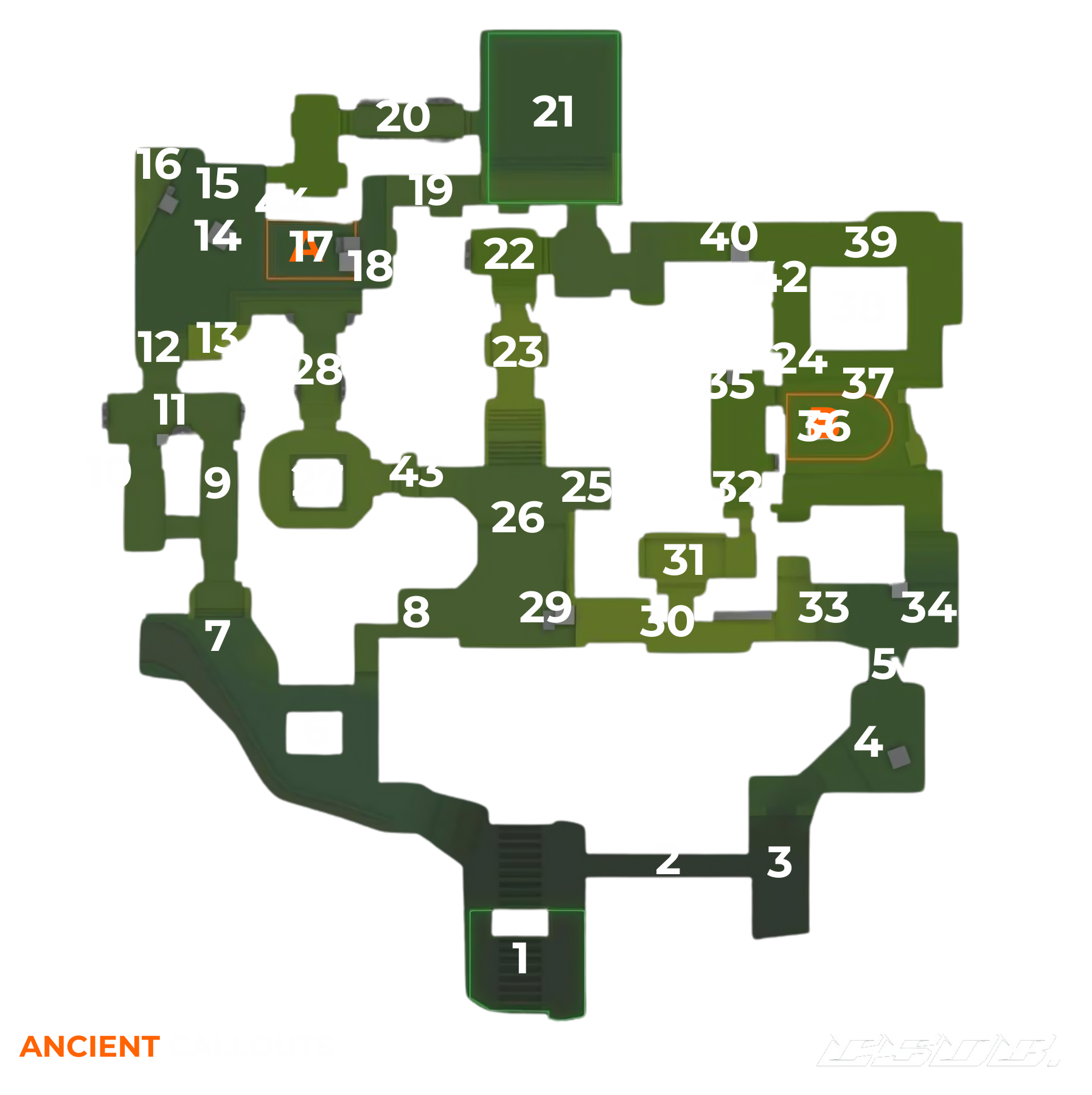Ancient Callouts




-
1T Spawn: This is the starting area for the Terrorist (T) team. It links to Tunnel and Split.
-
2Tunnel: This is the passageway connecting T Spawn to Water, often used for rushing B Site or accessing Mid.
-
3Water: The space between the Tunnel and Ruins.
-
4Ruins: This area connects to Doors, providing a quick route to the Ramp for Terrorists (Ts). It also contains a box for hiding from aggressive CTs.
-
5Doors: The double doors leading to T Lower from Ruins.
-
6Split: Links T Spawn to Elbow and Stairs, offering quick access to Mid and A Site.
-
7Stairs: Connects Split to A Halls.
-
8Elbow: Connects Split to Mid, often used for mid splits by Ts.
-
9A Halls: The A Halls connects Stairs to A Main, which provides an area for Ts to lurk and prevent Counter-Terrorists (CTs) pushes from A Site.
-
10Side Hall: The left side of the small room, which is commonly referred to as the hall.
-
11A Main: Leads into Long from A Halls.
-
12Long: One of two main entrances to A Site for Ts, allowing them to check Boost before entering.
-
13Boost: To the right of Long, CTs often boost teammates here to defend A Site.
-
14Big Box: A large crate next to A Site, notably different from Single.
-
15Single: A narrower crate near Plat that offers cover when defending the A Site.
-
16Plat: A raised area near A Site's corner.
-
17A Site: The A Site encompasses the area between CT Lane, Short, and Big Box, and it serves as the main location for planting the bomb on A.
-
18Triple Box: A trio of boxes that are positioned towards the rear of A Site, offering Ts a secure planting spot when CTs are occupying CT Lane.
-
19CT Lane: Connects CT Spawn to the A Site, providing one of two quick entrances for CTs to access the A Site.
-
20Temple: This is the pathway linking CT Spawn to A Site.
-
21CT Spawn: The Counter-Terrorist team's spawning area, connecting to Temple, CT Lane, Snipers Nest, and Alley.
-
22Snipers Nest: Double doors offering CTs a clear view of Mid, which is ideal for sniping.
-
23Top Mid: Stairs and a tunnel linking Mid to the Sniper's Nest.
-
24Second Lane: A nearby passage that provides defensive players access to the B site.
-
25Pit: The Pit is the spacious alcove which is located opposite the Tunnels in Mid.
-
26Mid: The central, open section of the map that grants Ts entry to A Side via Elbow or Heaven.
-
27Tunnels: Connecting Mid to Short, Tunnels are often used by Ts for A Site splits or by CTs to support Snipers Nest.
-
28Short: One of two primary Ts entry points to A Site, directly linked to A Site, but tricky to push without Long support.
-
29Xbox: A pair of crates that are adjacent to Heaven on Mid, offering access to Heaven from Mid.
-
30Heaven: The area linking T Lower to Lamp Room and Mid, used by Ts for mid splits, with teammates supporting from Elbow.
-
31Lamp Room: The area linking Heaven to Dark.
-
32Dark: A small area that connects Lamp Room to House, featuring a concealed spot for CT ambushes.
-
33T Lower: The area between Ramp and Heaven, known for its lower elevation compared to other parts of the map.
-
34Ramp: A slope which connects T Lower to B Site and acts as one of two main entry points for Ts when attacking B Site.
-
35House: Connects Lamp Room to B Site which is considered a tough entry point due to its narrow doorway.
-
36B Site: The area bounded by Ramp, House, and Square, designated for bomb planting.
-
37Pillar: Pillar is the stone and wooden structure placed on B Site, which is a great cover point for CTs to use when defending the site.
-
38Square: The large, square structure which is placed between Back Halls and B Site. It gives players two alternative routes to B Site from the Back Halls.
-
39Back Halls: Back Halls is the area which connects the Alley to Square.
-
40Alley: This is the area connecting the CT Spawn spot to Back Halls.
-
41Heaven: Heaven is the area which connects T Lower to Lamp Room and Mid. It can be used by Ts for a mid split, with supporting teammates pushing from Elbow.
-
42First Lane: A distant passage that provides defensive players with access to the B site.
-
43Chamber Lane: This area is situated in front of the entrance to the donut.
-
44Back Site: The rear section of the A site, positioned in front of the hall.
One of the most distinguishing features of Ancient is the vibrant coloring of its bombsites: A Site is marked by orange hues, while B Site boasts a distinctive pale blue color scheme. However, it’s packed with key positions that you need to be able to communicate to your teammates -which is why learning the callouts is so important.
The Importance of Learning Ancient Callouts
The Counter-Strike community first encountered the Ancient map in December 2020. Set in Mexico amidst the remnants of an ancient civilization, Valve officially added it to the Active Duty pool in May 2021. It may not be the newest map out there, but it’s certainly one of the most popular. Given its competitive viability and inclusion in official matchmaking, understanding Ancient callouts is essential for all CS:GO players.
In the heat of a match, quick and precise communication of your position – and that of your enemies, is paramount. Our guide on Ancient callouts should help you with more effective teamwork, and help you and your team to win. While the map’s newness means callout traditions are still evolving, this guide should help you coordinate with your team so you are on the same page when communicating the main positions on the map.
Ancient Callouts FAQs
What are callouts in CS:GO?
Callouts are specific names or terms used by players to communicate various locations or areas on a map – such as T upper, T ramp, etc, during a match. Effective callouts help teams to effectively coordinate with each other.
Why are callouts important in CS:GO?
Callouts are incredibly important for effective communication during gameplay. They allow players to quickly and accurately convey their position, enemy locations, and strategic information to their teammates, helping them with coordinated actions and maximizing their overall team performance.
Why is it important to learn Ancient callouts?
Learning Ancient callouts is important for any CS:GO player who wants to do well on the map. Understanding and using consistent callouts improve teamwork, coordination, and overall gameplay effectiveness. It helps players communicate efficiently and make more informed decisions based on their team’s positions and enemy movements.
How are Ancient callouts determined?
Ancient callouts are normally determined by the CS:GO community through consensus and use over time. Players generally experiment with different names for locations based on their characteristics, positions, and strategic significance. Eventually, widely accepted callouts start to emerge and become standardized among players.
Are there official callouts for Ancient?
As of now, there have been no official callouts designated by the game developers for Ancient. Callouts on Ancient are largely community-driven and may vary slightly among players and teams. However, certain locations may have established names that are commonly used by the community.
How can I learn Ancient callouts?
You can learn Ancient callouts by studying maps, understanding the main positions, watching gameplay videos, and practising in-game. You should pay attention to how the more experienced players communicate and name locations they use during matches. Additionally, it’s a good idea to actively participate in matches and communicate with teammates, which will help you reinforce and internalize Ancient callouts.
What should I do if my teammates use different callouts on Ancient?
If your teammates use different callouts on Ancient, you’ll need to work together to adapt and communicate effectively. Try to understand their terminology and use it to convey information clearly. Consistent communication and flexibility are key to being successful as a team – so be open to adjusting your callouts to match your team’s preferences.
Can I create my own callouts for Ancient?
Yes, you can create your own callouts for Ancient if you think they will help with communication and teamwork. However, you should make sure that your callouts are clear, concise, and easily understood by your teammates. Consistency and clarity are crucial if you want to communicate effectively with your teammates during gameplay.